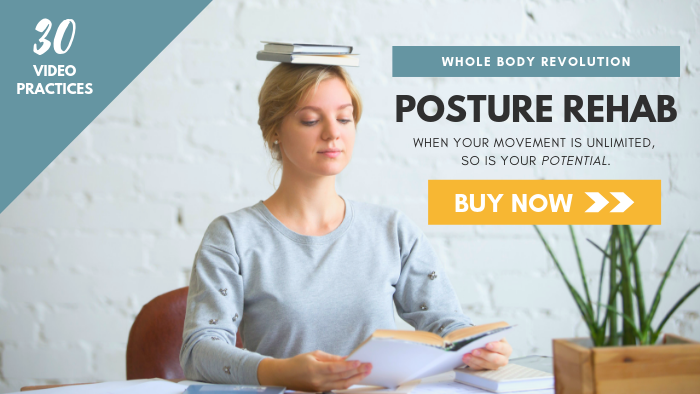Recently, I received an interesting email from a potential client. The subject read: “Do you work with fat bodies?”
And it got me thinking.
(The answer, by the way, is an unequivocal yes, absolutely, 100%. I work with all bodies in a judgement-free setting.)
Most posture advice tells you…
- To build core strength.
- To stand tall and pull your shoulders back.
- To tuck your stomach in.
And to lose weight if you’re more than 20 pounds heavier than you “should” be.
(As measured by an arbitrary chart from some mouldering textbook, of course.)
So, what I’m about to say might be pretty controversial. But I believe it’s my responsibility to tell you the truth.
Here goes…
You do not need to lose weight to improve your posture.
You do not need to lose weight to get rid of back pain.
You do not need to be skinnier to feel healthy in your body.
Will Weight Loss Improve Your Posture?
It seems that we’re awash in a sea of conventional wisdom which decrees that weight loss will magically improve your posture.
The thinking goes something like this:
Too much weight strains joints. Abdominal muscles cannot contract when there is belly fat present. Core strength suffers. Posture sags. You wind up a crumpled up hunchback.
Oof. Sorry, but this is a load of crap.
While researching for this article, I came across a multitude of blogs and websites — many of which were written by medical professionals — proffering postural absurdities such as:
- Your abdominal muscles cannot contract when you have belly fat
- The spine can’t move when there is fat around your midsection
- Fat pulls your body downward, forcing you to slouch
Seriously?
Can you dance like this?
Don’t tell me spines can’t move when there’s fat around them.
Certainly, this notion is deeply rooted in bias.
Let me hand the mic over to Christine Kent, author of Saving the Whole Woman:
“A strange and destructive body-dysphoria predominates in modern exercise and therapy systems, which I believe has its roots in white male supremacy. It is probably no accident that the physical culture of male body-building coincided with European and American hunters and anthropologists bringing back photographic images of native bodies. The most obvious way to distance themselves from ‘savages’ was to abhor the native belly…
…by the 1930s control of the abdominal wall was the reigning paradigm in western culture and medicine. While Joseph Pilates proclaimed the value of extreme abdominal exercise, physical therapists Henry and Florence Kendall defined a 90-degree backward rotation of the pelvis as ‘neutral.’ Today, male body-dysphoria continues to reign supreme in yoga studios, gymnasiums, and physical and manual therapies.”
So.
Will losing weight improve your posture?
I would have to say no.
Now, I’m not a doctor. I’m not even going to touch the controversy over health and weight. That’s not my wheelhouse.
But posture and movement? You’d better believe I’ve got some things to say.
The Fallacy of Fitness and Health
I have many clients who, by all standards, would be considered fit. They do everything from Crossfit to yoga (and often both).
They are strong. They are lean.
And they have pain.
They come to me — as everyone does — to improve their posture and movement.
So if losing weight and getting stronger and having a core of steel were the secret to perfect posture, wouldn’t you assume these folks would have it dialed in?
I’d say so. They’re doing all the “right” things.
And that’s where it gets interesting. Because we’ve been sold a truth that may not really be functional…
That getting “in shape” will make us healthier.
We are told:
- Sitting is the new smoking.
- Focus on core strength.
- Squeeze your glutes, tuck your pelvis, hold your shoulders back.
Funny, but sitting doesn’t seem to cause modern hunter gatherers much pain — in spite of the fact that they spend about the same number of hours per day sitting (ten, in case you’re curious) as most Americans.
Listen…
How you do something is more important than what you actually do.
i.e. how you sit matters more than that you sit. How you walk matters more than that you are walking. (Yes, there are different ways to walk.)
And so on and so forth.
In short:
Dysfunctional movement patterns are dysfunctional no matter how strong or lean or fat you are.
Don’t Just Stand There! Improve Your Posture through Movement
Now, please don’t misunderstand me and think that I’m telling you to just sit around on your sofa snarfing Cheetos all day. Aside from the danger of permanently orange-stained fingertips, a sedentary lifestyle isn’t healthy.
Movement is good. Strength training is highly beneficial. We all need more of both.
However.
We’ve got a problem when it comes to posture. And that problem is that most people think it’s this static pose that you hold when sitting.
Movement, on the other hand, is thought to be distinct from posture. A whole other paradigm.
But the reality is that posture and movement are so intrinsically linked as to be functionally inseparable.
Movement is a part of posture. Posture is the shape your body holds while you’re doing a movement. They’re one and the same.
Posture is just as much a medium of expression as it is clinical, antiseptic alignment. Your posture will reveal all kinds of things about you in this current moment — mood, confidence, comfort in your body, etc.
Posture is akin to body language. You cannot separate either from the rest of a person.
Here’s the truth:
A focus on movement will improve your posture by default.
The better your body moves, the more easily it can be comfortably at rest.
Weight and Movement: The Bottom Line
Back to weight loss for a moment…
Many people are told: lose weight to improve your posture and pain.
But as I mentioned, this is a concept deeply rooted in racial and gender bias.
I have clients of all shapes and sizes who are able to improve posture and pain without losing weight. Your weight has no actual bearing on your ability to move your body (see video, above).
The bottom line…
If losing weight makes you feel better, and it’s something that you want to do, then you should do that.
If losing weight does not make you feel better, makes your pain worse, loads you with guilt, interferes in your relationships, and impinges on your social life, then you should not make yourself lose weight because someone else says it’s the right thing to do.
Focus not on what your body weighs, but how it feels. If you can’t move well, start there. But don’t assume that losing weight will fix your movement — it won’t.
A Radical Approach to Improve Your Posture
I am a Posture and Movement Specialist, but I don’t believe in good posture. That’s a pretty bold thing to say.
But hear me out…
What I have found over the years is that your body is smart. Super smart.
Bodies are like water. They want to find the path of least resistance.
Your body naturally wants to find neutral alignment — a place where it can rest, relax and feel at ease.
Good posture is not what you have been led to believe — a hyper-strict, rigid pose that you must strain to maintain.
Rather, good posture results from removing the tension in your body that impedes your body’s innate intelligence.
This is kind of a revolutionary approach, folks. It turns the whole posture conversation on its head.
But here’s why I think it’s important…
- This approach is kinder to your body. It’s easier to maintain. It rests on the foundation of relaxation over tension. People, we do not need to be more tense. We’re good there.
- This approach takes into account the whole person. It does not treat your body as a dumb object, but rather an intelligent system. And it circumvents white, patriarchal norms regarding bodies.
- This approach creates a foundation of safety and security so that your muscles can actually relax — and so can your brain. Because your brain is also tissue. Tension doesn’t just affect muscles. It also constricts your mind.
- This approach prioritizes your body’s individual intelligence rather than applying a general standard to everyone. One size fits all never works for anyone at all.
- This approach does not give you another thing to do. It teaches your body a whole new way to be.
And this approach is what I teach in my Posture Rehab course.
Because when your movement is unlimited, so is your potential.
And that’s what I want for you.
All bodies in all conditions, shapes, and sizes welcome.


Leave a Reply